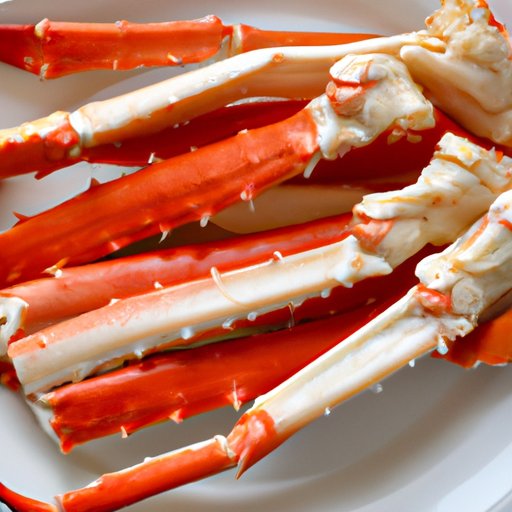
I. Introduction
If you’re a seafood lover, you know that crab legs are a real delicacy. Whether you’re preparing a fancy dinner for your guests or just want to indulge in a tasty treat, boiling crab legs is a great way to enjoy these succulent crustaceans. Boiling crab legs is easy once you follow our step-by-step guide and learn the best cooking tips and methods. In this article, we’ll show you everything you need to know about boiling crab legs, seasoning them properly, and serving them with delicious side dishes.
II. Step-by-Step Guide
Before you start boiling your crab legs, you’ll need to prepare your ingredients and tools. Here’s what you’ll need:
- Crab legs (fresh or frozen)
- A large pot
- A colander
- Sea salt or kosher salt
- Water
- Lemon wedges (optional)
- Butter or dipping sauce (optional)
When selecting your crab legs, look for fresh, firm, and shiny ones with no bad smell or signs of damage. If you’re buying frozen crab legs, make sure they’re thawed in the fridge overnight or in cold water for a few hours before boiling them.
Now that you have your ingredients and tools, here’s how to boil your crab legs:
- Fill your pot with enough water to cover the crab legs.
- Add a tablespoon of salt per quart of water to enhance the flavor of the crab legs.
- Bring the water to a boil over high heat.
- Add the crab legs to the pot, making sure they’re fully submerged in the water.
- Reduce the heat to medium and let the crab legs boil for 5-7 minutes for fresh crab legs, or 6-8 minutes for frozen crab legs.
- Use tongs or a slotted spoon to remove the crab legs from the pot and drain them in a colander.
- Place the crab legs on a serving platter and garnish them with lemon wedges, melted butter, or your favorite dipping sauce.
You can watch this video to see how to boil crab legs:
III. Cooking Tips
While boiling crab legs is a simple process, there are a few common mistakes you should avoid to ensure the best result:
- Don’t overcook your crab legs, or they’ll become tough and chewy.
- Don’t add too much salt to the water, or it’ll be too salty to taste.
- Don’t boil your crab legs for too long, or they’ll lose their flavor and texture.
- Don’t break or cut your crab legs before boiling them, or you’ll lose some of the precious meat.
To determine if your crab legs are cooked, look for these signs:
- The shell turns bright red and the meat is white and opaque.
- The crab legs are easily bendable and the shell cracks easily when you twist the legs.
- The internal temperature of the crab legs reaches 145°F (63°C) for at least 15 seconds.
To enhance the taste of your boiled crab legs, try these seasoning ideas:
- Garlic butter
- Lemon and parsley
- Old Bay seasoning
- Cajun or Creole seasoning
- Hot sauce or chili flakes
To safely handle and store your leftover crab legs, make sure to refrigerate them within two hours after cooking and consume them within three days.
IV. Recipe and Side Dishes
If you want to impress your guests or treat yourself to a tasty meal, try this delicious recipe for boiled crab legs:
Ingredients:
- 2 lbs. of crab legs
- 4 quarts of water
- 4 tbsp. of sea salt
- 1 lemon, sliced into wedges
- 1/2 stick of butter, melted
Preparation:
Place the water and salt in a large stockpot and bring to a boil. Add the crab legs and reduce the heat to medium. Cook for 6-8 minutes, or until the crab legs are fully cooked and pink. Drain the crab legs and transfer them to a serving platter. Serve with lemon wedges and melted butter on the side.
To complement the flavors of your boiled crab legs, try these side dishes:
- Corn on the cob
- Baked or mashed potatoes
- Grilled vegetables
- Green salad with vinaigrette
- Garlic bread or dinner rolls
Remember that the presentation is essential when serving boiled crab legs. Arrange the crab legs on a large platter with the garnishes and side dishes nicely displayed. You can even add some parsley or chives for an extra touch of color and freshness.
V. Benefits of Eating Crab Legs
Aside from being a delicious treat, crab legs also offer numerous health benefits. Crab legs are a great source of protein and omega-3 fatty acids, which help reduce inflammation, promote heart health, and improve brain function. Crab legs are also low in fat and calories, making them an excellent option for a healthy and low-carb diet. Some of the most popular types of crab legs include King, Snow, Dungeness, and Blue crab, each with its unique flavor and texture.
If you’re looking for alternative ways to cook crab legs, you can try grilling or steaming them. Grilling crab legs gives them a smoky and charred flavor, while steaming preserves their moisture and sweetness. However, boiling remains the easiest and quickest way to cook crab legs, especially if you’re short on time or kitchen skills.
VI. Conclusion
Boiling crab legs is a straightforward and tasty way to enjoy the flavors of the sea. By following our step-by-step guide, cooking tips, and recipe ideas, you can impress your guests or have an indulgent meal in no time. Remember to select high-quality crab legs, avoid common mistakes, and experiment with different seasonings and side dishes to create your unique seafood delicacy.





